语言学基础期末复习提纲(整理版)
- 格式:doc
- 大小:48.00 KB
- 文档页数:5
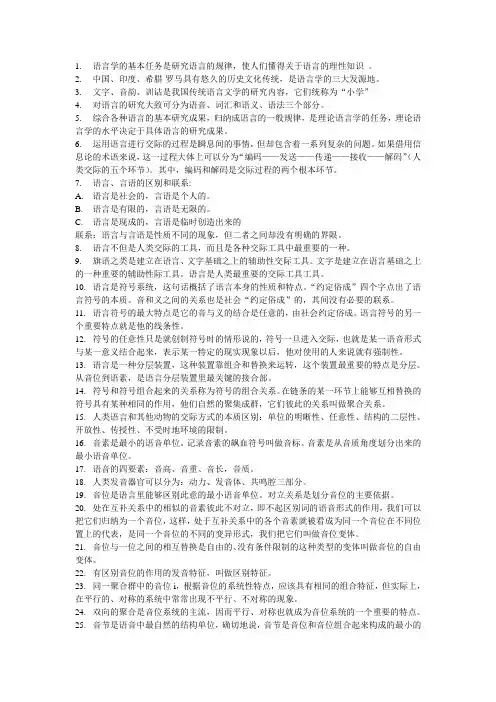
1. 语言学的基本任务是研究语言的规律,使人们懂得关于语言的理性知识。
2. 中国、印度、希腊-罗马具有悠久的历史文化传统,是语言学的三大发源地。
3. 文字、音韵、训诂是我国传统语言文学的研究内容,它们统称为“小学”4. 对语言的研究大致可分为语音、词汇和语义、语法三个部分。
5. 综合各种语言的基本研究成果,归纳成语言的一般规律,是理论语言学的任务,理论语言学的水平决定于具体语言的研究成果。
6. 运用语言进行交际的过程是瞬息间的事情,但却包含着一系列复杂的问题。
如果借用信息论的术语来说,这一过程大体上可以分为“编码——发送——传递——接收——解码”(人类交际的五个环节)。
其中,编码和解码是交际过程的两个根本环节。
7. 语言、言语的区别和联系:A. 语言是社会的,言语是个人的。
B. 语言是有限的,言语是无限的。
C. 语言是现成的,言语是临时创造出来的联系:语言与言语是性质不同的现象,但二者之间却没有明确的界限。
8. 语言不但是人类交际的工具,而且是各种交际工具中最重要的一种。
9. 旗语之类是建立在语言、文字基础之上的辅助性交际工具。
文字是建立在语言基础之上的一种重要的辅助性际工具。
语言是人类最重要的交际工具工具。
10. 语言是符号系统,这句话概括了语言本身的性质和特点。
“约定俗成”四个字点出了语言符号的本质。
音和义之间的关系也是社会“约定俗成”的,其间没有必要的联系。
11. 语言符号的最大特点是它的音与义的结合是任意的,由社会约定俗成。
语言符号的另一个重要特点就是他的线条性。
12. 符号的任意性只是就创制符号时的情形说的,符号一旦进入交际,也就是某一语音形式与某一意义结合起来,表示某一特定的现实现象以后,他对使用的人来说就有强制性。
13. 语言是一种分层装置,这种装置靠组合和替换来运转,这个装置最重要的特点是分层。
从音位到语素,是语言分层装置里最关键的接合部。
14. 符号和符号组合起来的关系称为符号的组合关系。
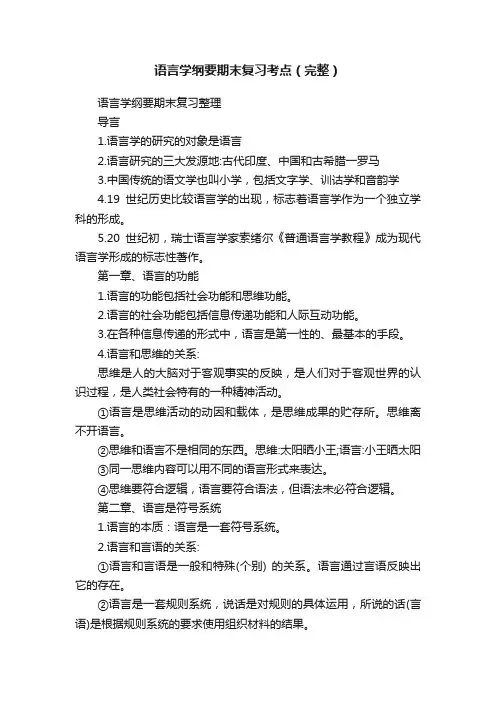
语言学纲要期末复习考点(完整)语言学纲要期末复习整理导言1.语言学的研究的对象是语言2.语言研究的三大发源地:古代印度、中国和古希腊一罗马3.中国传统的语文学也叫小学,包括文字学、训诂学和音韵学4.19世纪历史比较语言学的出现,标志着语言学作为一个独立学科的形成。
5.20世纪初,瑞士语言学家索绪尔《普通语言学教程》成为现代语言学形成的标志性著作。
第一章、语言的功能1.语言的功能包括社会功能和思维功能。
2.语言的社会功能包括信息传递功能和人际互动功能。
3.在各种信息传递的形式中,语言是第一性的、最基本的手段。
4.语言和思维的关系:思维是人的大脑对于客观事实的反映,是人们对于客观世界的认识过程,是人类社会特有的一种精神活动。
①语言是思维活动的动因和载体,是思维成果的贮存所。
思维离不开语言。
②思维和语言不是相同的东西。
思维:太阳晒小王;语言:小王晒太阳③同一思维内容可以用不同的语言形式来表达。
④思维要符合逻辑,语言要符合语法,但语法未必符合逻辑。
第二章、语言是符号系统1.语言的本质:语言是一套符号系统。
2.语言和言语的关系:①语言和言语是一般和特殊(个别) 的关系。
语言通过言语反映出它的存在。
②语言是一套规则系统,说话是对规则的具体运用,所说的话(言语)是根据规则系统的要求使用组织材料的结果。
③语言是社会的,言语是个人的。
语言是社会约定俗成的,而言语是个人行为。
3.符号的基本性质:符号的形式和意义之间没有本质上的、自然属性上的必然联系,是社会约定俗成的。
4.语言符号用人类发出的声音作为自己的形式,是音和义的结合体。
5.能指是指语言符号的物质实体,也就是能够指称某种意义的成分,即形式,如汉语中的语音和汉字。
所指是指符号所指的意义内容,也就是“能指成分”,即特定的物质实体所指的意义内容。
即:能指=形式;所指=意义内容6.语言符号的性质:①任意性:语言符号最突出的特点就是它的音义结合的任意性。
②强制性:音义关系一经社会约定而进入交际之后,它对人们就有强制性。
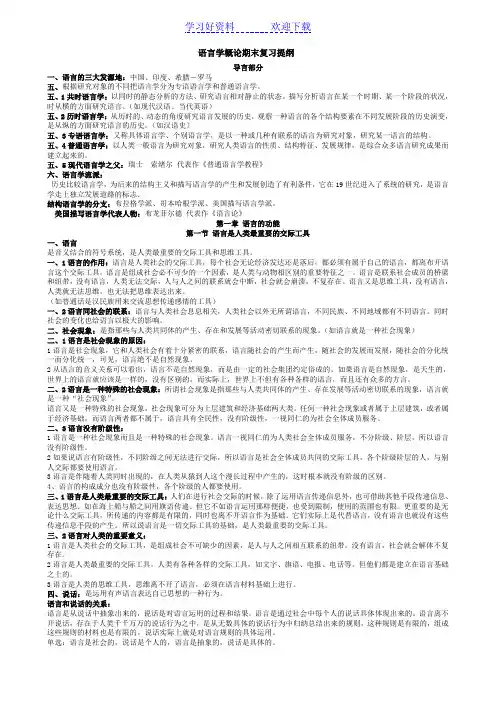
语言学概论期末复习提纲导言部分一、语言的三大发源地:中国、印度、希腊-罗马五、根据研究对象的不同把语言学分为专语语言学和普通语言学。
五、1共时语言学:以同时的静态分析的方法、研究语言相对静止的状态。
描写分析语言在某一个时期、某一个阶段的状况,时从横的方面研究语言。
(如现代汉语、当代英语)五、2历时语言学:从历时的、动态的角度研究语言发展的历史,观察一种语言的各个结构要素在不同发展阶段的历史演变,是从纵的方面研究语言的历史。
(如汉语史)五、3专语语言学:又称具体语言学、个别语言学,是以一种或几种有联系的语言为研究对象,研究某一语言的结构。
五、4普通语言学:以人类一般语言为研究对象,研究人类语言的性质、结构特征、发展规律,是综合众多语言研究成果而建立起来的。
五、5现代语言学之父:瑞士索绪尔代表作《普通语言学教程》六、语言学流派:历史比较语言学,为后来的结构主义和描写语言学的产生和发展创造了有利条件,它在19世纪进入了系统的研究,是语言学走上独立发展道路的标志。
结构语言学的分支:布拉格学派、哥本哈根学派、美国描写语言学派。
美国描写语言学代表人物:布龙菲尔德代表作《语言论》第一章语言的功能第一节语言是人类最重要的交际工具一、语言是音义结合的符号系统,是人类最重要的交际工具和思维工具。
一、1语言的作用:语言是人类社会的交际工具,每个社会无论经济发达还是落后,都必须有属于自己的语言,都离布开语言这个交际工具。
语言是组成社会必不可少的一个因素,是人类与动物相区别的重要特征之一。
语言是联系社会成员的桥梁和纽带,没有语言,人类无法交际,人与人之间的联系就会中断,社会就会崩溃,不复存在。
语言又是思维工具,没有语言,人类就无法思维,也无法把思维表达出来。
(如普通话是汉民族用来交流思想传递感情的工具)一、2语言同社会的联系:语言与人类社会息息相关,人类社会以外无所谓语言,不同民族、不同地域都有不同语言。
同时社会的变化也给语言以极大的影响。
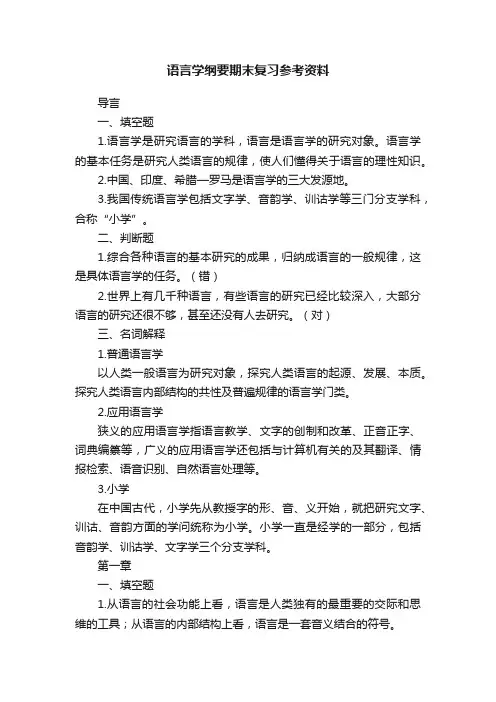
语言学纲要期末复习参考资料导言一、填空题1.语言学是研究语言的学科,语言是语言学的研究对象。
语言学的基本任务是研究人类语言的规律,使人们懂得关于语言的理性知识。
2.中国、印度、希腊—罗马是语言学的三大发源地。
3.我国传统语言学包括文字学、音韵学、训诂学等三门分支学科,合称“小学”。
二、判断题1.综合各种语言的基本研究的成果,归纳成语言的一般规律,这是具体语言学的任务。
(错)2.世界上有几千种语言,有些语言的研究已经比较深入,大部分语言的研究还很不够,甚至还没有人去研究。
(对)三、名词解释1.普通语言学以人类一般语言为研究对象,探究人类语言的起源、发展、本质。
探究人类语言内部结构的共性及普遍规律的语言学门类。
2.应用语言学狭义的应用语言学指语言教学、文字的创制和改革、正音正字、词典编纂等,广义的应用语言学还包括与计算机有关的及其翻译、情报检索、语音识别、自然语言处理等。
3.小学在中国古代,小学先从教授字的形、音、义开始,就把研究文字、训诂、音韵方面的学问统称为小学。
小学一直是经学的一部分,包括音韵学、训诂学、文字学三个分支学科。
第一章一、填空题1.从语言的社会功能上看,语言是人类独有的最重要的交际和思维的工具;从语言的内部结构上看,语言是一套音义结合的符号。
2.文字是建立在语言基础之上的最重要的辅助交际工具,旗语之类是建立在语言和文字基础上的特殊领域的辅助交际工具。
二、判断1.从理论上来说,句子的长度是可以无限的。
(对)2.语言是文字基础上产生的人类最重要的交际工具。
(错)3.文字始终是从属于语言的。
(错)4.思维离不开语言,语言也离不开思维。
(对)5.语言和思维互相依存共同发展。
(对)6.在现代社会,文字比语言更加重要。
(错)7.文字也是人类最重要的交际工具。
(错)8.语言是组成社会的一个不可缺少的因素。
(对)9.会不会说话是人类和动物的根本区别之一。
(对)10.思维能力是全人类共同的,语言是各民族不同的。
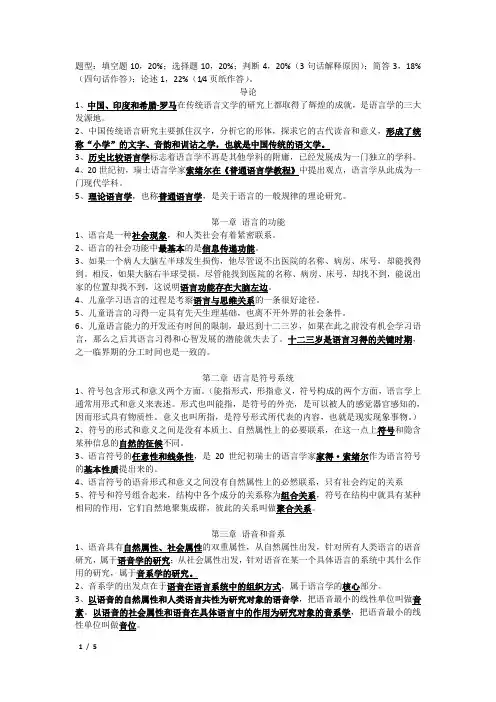
题型:填空题10,20%;选择题10,20%;判断4,20%(3句话解释原因);简答3,18%(四句话作答);论述1,22%(1/4页纸作答)。
导论1、中国、印度和希腊-罗马在传统语言文学的研究上都取得了辉煌的成就,是语言学的三大发源地。
2、中国传统语言研究主要抓住汉字,分析它的形体,探求它的古代读音和意义,形成了统称“小学”的文字、音韵和训诂之学,也就是中国传统的语文学。
3、历史比较语言学标志着语言学不再是其他学科的附庸,已经发展成为一门独立的学科。
4、20世纪初,瑞士语言学家索绪尔在《普通语言学教程》中提出观点,语言学从此成为一门现代学科。
5、理论语言学,也称普通语言学,是关于语言的一般规律的理论研究。
第一章语言的功能1、语言是一种社会现象,和人类社会有着紧密联系。
2、语言的社会功能中最基本的是信息传递功能。
3、如果一个病人大脑左半球发生损伤,他尽管说不出医院的名称、病房、床号,却能找得到。
相反,如果大脑右半球受损,尽管能找到医院的名称、病房、床号,却找不到,能说出家的位置却找不到,这说明语言功能存在大脑左边。
4、儿童学习语言的过程是考察语言与思维关系的一条很好途径。
5、儿童语言的习得一定具有先天生理基础,也离不开外界的社会条件。
6、儿童语言能力的开发还有时间的限制,最迟到十二三岁,如果在此之前没有机会学习语言,那么之后其语言习得和心智发展的潜能就失去了。
十二三岁是语言习得的关键时期,之一临界期的分工时间也是一致的。
第二章语言是符号系统1、符号包含形式和意义两个方面。
(能指形式,形指意义,符号构成的两个方面,语言学上通常用形式和意义来表述。
形式也叫能指,是符号的外壳,是可以被人的感觉器官感知的,因而形式具有物质性。
意义也叫所指,是符号形式所代表的内容,也就是现实现象事物。
)2、符号的形式和意义之间是没有本质上、自然属性上的必要联系,在这一点上符号和隐含某种信息的自然的征候不同。
3、语言符号的任意性和线条性,是20世纪初瑞士的语言学家家得·索绪尔作为语言符号的基本性质提出来的。
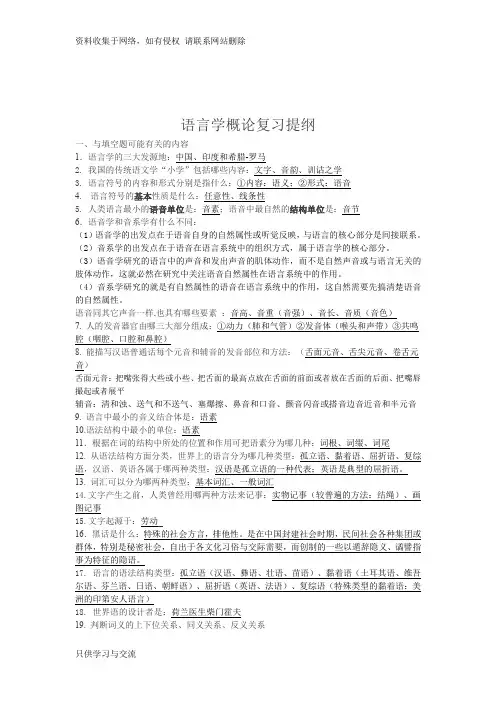
语言学概论复习提纲一、与填空题可能有关的内容1.语言学的三大发源地:中国、印度和希腊-罗马2. 我国的传统语文学“小学”包括哪些内容:文字、音韵、训诂之学3. 语言符号的内容和形式分别是指什么:①内容:语义;②形式:语音4. 语言符号的基本性质是什么:任意性、线条性5.人类语言最小的语音单位是:音素;语音中最自然的结构单位是:音节6.语音学和音系学有什么不同:(1)语音学的出发点在于语音自身的自然属性或听觉反映,与语言的核心部分是间接联系。
(2)音系学的出发点在于语音在语言系统中的组织方式,属于语言学的核心部分。
(3)语音学研究的语言中的声音和发出声音的肌体动作,而不是自然声音或与语言无关的肢体动作,这就必然在研究中关注语音自然属性在语言系统中的作用。
(4)音系学研究的就是有自然属性的语音在语言系统中的作用,这自然需要先搞清楚语音的自然属性。
语音同其它声音一样,也具有哪些要素:音高、音重(音强)、音长、音质(音色)7. 人的发音器官由哪三大部分组成:①动力(肺和气管)②发音体(喉头和声带)③共鸣腔(咽腔、口腔和鼻腔)8. 能描写汉语普通话每个元音和辅音的发音部位和方法:(舌面元音、舌尖元音、卷舌元音)舌面元音:把嘴张得大些或小些、把舌面的最高点放在舌面的前面或者放在舌面的后面、把嘴唇撮起或者展平辅音:清和浊、送气和不送气、塞爆擦、鼻音和口音、颤音闪音或搭音边音近音和半元音9. 语言中最小的音义结合体是:语素10.语法结构中最小的单位:语素11.根据在词的结构中所处的位置和作用可把语素分为哪几种:词根、词缀、词尾12. 从语法结构方面分类,世界上的语言分为哪几种类型:孤立语、黏着语、屈折语、复综语,汉语、英语各属于哪两种类型:汉语是孤立语的一种代表;英语是典型的屈折语。
13. 词汇可以分为哪两种类型:基本词汇、一般词汇14.文字产生之前,人类曾经用哪两种方法来记事:实物记事(较普遍的方法:结绳)、画图记事15.文字起源于:劳动16.黑话是什么:特殊的社会方言,排他性。
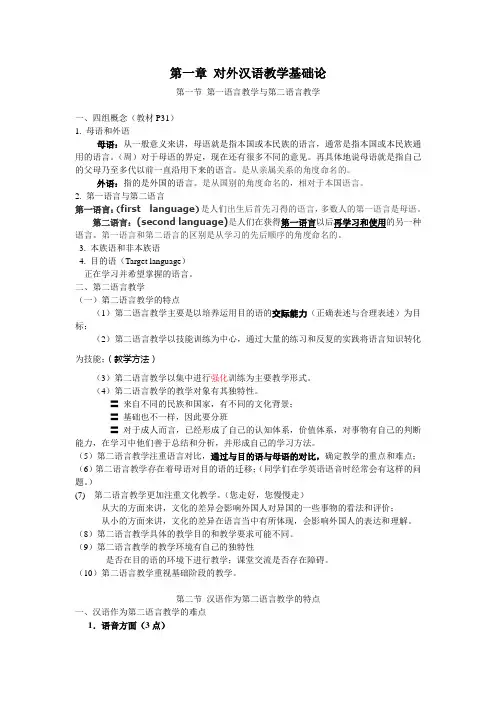
第一章对外汉语教学基础论第一节第一语言教学与第二语言教学一、四组概念(教材P31)1. 母语和外语母语:从一般意义来讲,母语就是指本国或本民族的语言,通常是指本国或本民族通用的语言。
(周)对于母语的界定,现在还有很多不同的意见。
再具体地说母语就是指自己的父母乃至多代以前一直沿用下来的语言。
是从亲属关系的角度命名的。
外语:指的是外国的语言。
是从国别的角度命名的,相对于本国语言。
2. 第一语言与第二语言第一语言:(first language)是人们出生后首先习得的语言,多数人的第一语言是母语。
第二语言:(second language)是人们在获得第一语言以后再学习和使用的另一种语言。
第一语言和第二语言的区别是从学习的先后顺序的角度命名的。
3. 本族语和非本族语4. 目的语(Target language)正在学习并希望掌握的语言。
二、第二语言教学(一)第二语言教学的特点(1)第二语言教学主要是以培养运用目的语的交际能力(正确表述与合理表述)为目标;(2)第二语言教学以技能训练为中心,通过大量的练习和反复的实践将语言知识转化为技能;(教学方法)(3)第二语言教学以集中进行强化训练为主要教学形式。
(4)第二语言教学的教学对象有其独特性。
〓来自不同的民族和国家,有不同的文化背景;〓基础也不一样,因此要分班〓对于成人而言,已经形成了自己的认知体系,价值体系,对事物有自己的判断能力,在学习中他们善于总结和分析,并形成自己的学习方法。
(5)第二语言教学注重语言对比,通过与目的语与母语的对比,确定教学的重点和难点;(6)第二语言教学存在着母语对目的语的迁移;(同学们在学英语语音时经常会有这样的问题。
)(7)第二语言教学更加注重文化教学。
(您走好,您慢慢走)从大的方面来讲,文化的差异会影响外国人对异国的一些事物的看法和评价;从小的方面来讲,文化的差异在语言当中有所体现,会影响外国人的表达和理解。
(8)第二语言教学具体的教学目的和教学要求可能不同。
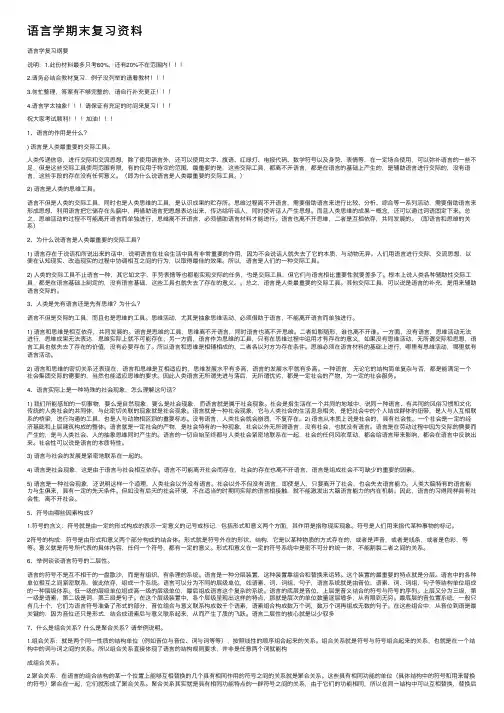
语⾔学期末复习资料语⾔学复习纲要说明:1.此份材料最多只考80%,还有20%不在范围内2.请务必结合教材复习,例⼦没列举的请看教材3.匆忙整理,答案有不够完整的,请⾃⾏补充更正4.语⾔学太抽象请保证有充⾜的时间来复习祝⼤家考试顺利加油1、语⾔的作⽤是什么?) 语⾔是⼈类最重要的交际⼯具。
⼈类传递信息,进⾏交际和交流思想,除了使⽤语⾔外,还可以使⽤⽂字、旗语、红绿灯、电报代码、数学符号以及⾝势、表情等,在⼀定场合使⽤,可以弥补语⾔的⼀些不⾜,但是这些交际⼯具使⽤范围有限,有的仅⽤于特定的范围,最重要的是,这些交际⼯具,都离不开语⾔,都是在语⾔的基础上产⽣的,是辅助语⾔进⾏交际的,没有语⾔,这些⼿段的存在没有任何意义。
(即为什么说语⾔是⼈类最重要的交际⼯具。
)2) 语⾔是⼈类的思维⼯具。
语⾔不但是⼈类的交际⼯具,同时也是⼈类思维的⼯具,是认识成果的贮存所。
思维过程离不开语⾔,需要借助语⾔来进⾏⽐较、分析、综合等⼀系列活动,需要借助语⾔来形成思想,利⽤语⾔把它储存在头脑中,再借助语⾔把思想表达出来,传达给听话⼈,同时使听话⼈产⽣思想。
⽽且⼈类思维的成果-概念,还可以通过词语固定下来。
总之,思维活动的过程不可能离开语⾔⽽单独进⾏,思维离不开语⾔,必须借助语⾔材料才能进⾏。
语⾔也离不开思维,⼆者是互相依存,共同发展的。
(即语⾔和思维的关系)2、为什么说语⾔是⼈类最重要的交际⼯具?1) 语⾔存在于说话和所说出来的话中,说明语⾔在社会⽣活中具有⾮常重要的作⽤,因为不会说话⼈就失去了它的本质,与动物⽆异。
⼈们⽤语⾔进⾏交际,交流思想,以便在认知现实、改造现实的过程中协调相互之间的⾏为,以取得最佳的效果。
所以,语⾔是⼈们的⼀种交际⼯具。
2) ⼈类的交际⼯具不⽌语⾔⼀种,其它如⽂字、⼿势表情等也都能实现交际的任务,也是交际⼯具,但它们与语⾔相⽐重要性就要差多了。
根本上说⼈类各种辅助性交际⼯具,都是在语⾔基础上制定的,没有语⾔基础,这些⼯具也就失去了存在的意义。
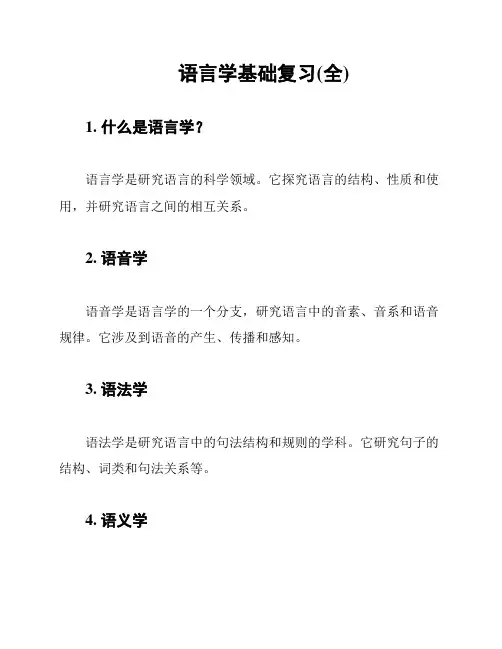
语言学基础复习(全)
1. 什么是语言学?
语言学是研究语言的科学领域。
它探究语言的结构、性质和使用,并研究语言之间的相互关系。
2. 语音学
语音学是语言学的一个分支,研究语言中的音素、音系和语音规律。
它涉及到语音的产生、传播和感知。
3. 语法学
语法学是研究语言中的句法结构和规则的学科。
它研究句子的结构、词类和句法关系等。
4. 语义学
语义学研究语言中词语、短语和句子的意义。
它关注词义、义项和语义关系等。
5. 语用学
语用学研究语言的使用方式和交际功能。
它研究语言的意图、推理和上下文等因素。
6. 语言变异和语言变化
语言变异和语言变化是研究语言不同方言、变体以及语言演变过程的学科。
7. 语言学与其他学科的关系
语言学与其他学科如心理学、认知科学、社会学和人机交互等有紧密的联系和应用。
8. 语言学的研究方法
语言学采用多种研究方法,包括实地调查、语料库研究、实验
研究和理论推导等。
9. 语言学的应用领域
语言学的应用领域包括教育、语言教学、翻译、语音识别、自
然语言处理等。
10. 语言学的发展前景
随着科技的进步和社会的发展,语言学在多个领域将继续发展,如自然语言处理、人机交互、机器翻译等。
以上是对语言学基础的简要复习,希望能够帮助你加深对语言
学的理解。
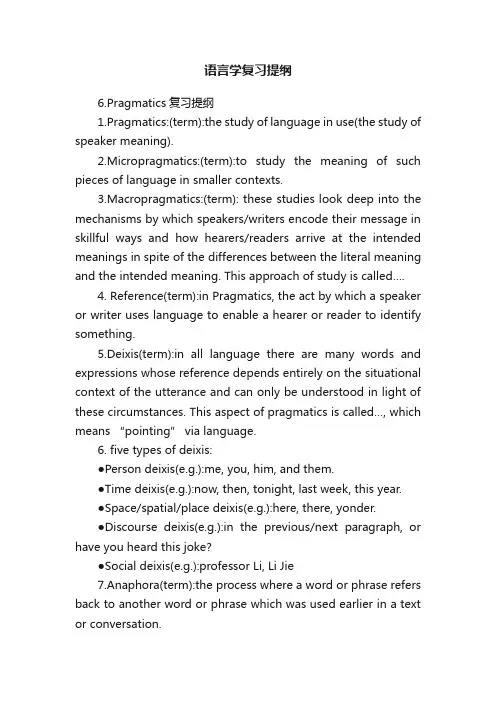
语言学复习提纲6.Pragmatics复习提纲1.Pragmatics:(term):the study of language in use(the study of speaker meaning).2.Micropragmatics:(term):to study the meaning of such pieces of language in smaller contexts.3.Macropragmatics:(term): these studies look deep into the mechanisms by which speakers/writers encode their message in skillful ways and how hearers/readers arrive at the intended meanings in spite of the differences between the literal meaning and the intended meaning. This approach of study is called….4. Reference(term):in Pragmatics, the act by which a speaker or writer uses language to enable a hearer or reader to identify something.5.Deixis(term):in all language there are many words and expressions whose reference depends entirely on the situational context of the utterance and can only be understood in light of these circumstances. This aspect of pragmatics is called…, which means “pointing” via language.6. five types of deixis:●Person deixis(e.g.):me, you, him, and them.●Time deixis(e.g.):now, then, tonight, last week, this year.●Space/spatial/place deixis(e.g.):here, there, yonder.●Discourse deixis(e.g.):in the previous/next paragraph, or have you heard this joke?●Social dei xis(e.g.):professor Li, Li Jie7.Anaphora(term):the process where a word or phrase refers back to another word or phrase which was used earlier in a text or conversation.8. Presupposition(term):assumptions by the speaker or writer.9.Presupposition triggers:●Definitive description(e.g.):he saw the man with two heads→there exists a man with twoheads.●Factive verbs(e.g.):he realized that he was in debt.●Change of state verbs(e.g.):he began to beat her husband.●Lteratives(e.g.):the flying saucer came again.●T emporal clauses(e.g.):while he was revolutionizing linguistics.●Cleft sentences(e.g.):it was he that kissed her.●Comparisons and contrasts(e.g.):he is a better linguist than him.10.Speech act(term)actions performed via utterance.11. locutionary act (term) the act of saying, the literal meaning of the utterancee.g. there is not enough fresh air in here.12. Illocutionary act (term)the extra meaning of the utterance produced on the basis of its literal meaninge.g. the hearer to open the window13.per locutionary act(term)the effect of the utterance on the hearer, depending on specific circumstances.e.g. the hearer′s opening the window or his refusal to do so14. classification of illocutionary acts●Representatives:e.g.:the earth is flat/it wa s a warm sunny day/Chomsky did not write aboutmusic.●Directives e.g.:gimme a cup of coffee. Make it black/could you lend me a pen,please?/do nottouch that●Commissives e.g.:I will be back/I am going to get it right next time/we will not do that●Express ives e.g.:I am really sorry/congratulations/oh, yes, great,mmm, ssahh●Declarations e.g.:6.3.2 The Cooperative principle6.3.2.1 The Cooperative principle and its maxims合作原则一定要完整地背下来,分析实例时要以各准则为标准分析会话含义*****要会评价合作原则,它的优势与弊端,书中能找到论述,结合礼貌原则进行评论。

语言学复习提纲:语音学与语法学要点
一、语音学要点
1. 发音器官与音素
•发音器官包括声门、舌头、唇等部位,能够产生不同音素。
•音素是语言中的最小音位单位,分为元音和辅音等。
2. 声调与音节
•声调是语言中一个音节的音高变化。
•音节是一个完整的语音单位,包含元音和辅音。
3. 音变与语音规则
•音变是一种音素发音的变化规律。
•语音规则是对语言中音素发音的稳定规范。
二、语法学要点
1. 词类与句子成分
•词类包括名词、动词、形容词等,是构成句子的基本单位。
•句子成分包括主语、谓语、宾语等,构成句子的结构要素。
2. 句法关系与语法规则
•句法关系指不同句子成分之间的关系。
•语法规则是组织句子成分的规律,保证句子构成符合语言习惯。
3. 语法意义与语法功能
•语法意义是句子结构所表达的含义。
•语法功能是句子中成分在语言交际中所承担的作用。
三、总结
以上是语言学中语音学与语法学的要点内容,通过学习这些基本知识,可以更好地理解语言的结构和功能。
细致的复习与实践可以帮助我们提高语言表达和沟通能力,在日常生活和学习工作中更加游刃有余。
提示:1、选择题和判断题不划范围,要想取高分需要全面复习。
(包括自学部分)2、分析题要根据题型有针对性地复习。
3、答名词解释、简答、论述题时尽量举例。
填空涉及内容:1、使语言符号系统非常灵巧的要素。
任意性,散离性,层级性。
2、七大语言机制1.预设机制 2.排除机制 3. 补偿机制 4.多余机制 5.类推机制6.对称机制7.经济机制3、地域方言的差异主要表现哪些方面?语音词汇语法4、语音的物理性要素。
音高音强音长音色5、语素的类别。
(音节形式)单音节语素和多音节语素(构词能力)成词语素和不成词语素(位置是否固定)定位语素和不定位语素(构句能力)自由语素和粘着语素(在词中的不同作用)词根语素和附加语素6、两个言语过程P177直接言语行为过程和间接言语行为过程7、词语感情色彩的转移。
爪牙:古义指勇士,是对勇猛善战的武臣的敬称。
今指恶势力的党羽、帮凶(1)指武臣。
《诗·小雅·祈父》:“祈父!予王之爪牙。
”《汉书·李广传》:“将军者,国之爪牙也。
”《汉书·陈汤传》:“战克之将,国之爪牙,不可不重。
”(2)指羽翼;辅佐的人。
《后汉书·窦宪传》:“宪既平匈奴,威名大盛,以任尚等为爪牙。
”(3)今多用作贬义指帮凶。
如:帝国主义的爪牙。
深刻:(古)多形容刑罚严酷苛刻,残忍不仁,多有贬义。
“是以狱吏专为深刻,残贼而亡极,偷为一切,不顾国患,此世之大贼也…天下之患,莫深于狱;败法乱政,离亲塞道,莫甚乎治狱之吏”《汉书·路温舒传》(今)形容对事理理解或阐释得透彻,深入到本质,具有褒义。
8、语音演变规律的特点。
条件性时间性地域性9、言语过程的三个不同阶段。
10、人类语言的构造词汇系统、语法系统11、对于一个句子的结构分析应该从哪两方面着手。
显性语法关系隐性语法关系12、言语行为的理论的提出者。
英国语言哲学家奥斯汀13、言语交际中的礼貌原则(提出者以及包含的准则)。
语言学-期末复习资料-整理版Chapter one Introduction一、定义1.语言学LinguisticsLinguistics is generally defined as the scientific study of language.2.普通语言学General LinguisticsThe study of language as a whole is often called General linguistics.3.语言language$Language is a system of arbitrary vocal symbols used for human communication.语言是人类用来交际的任意性的有声符号体系。
4.识别特征Design FeaturesIt refers to the defining poperties of human language that distinguish it from any animal system of communication.语言识别特征是指人类语言区别与其他任何动物的交际体系的限定性特征。
Arbitrariness任意性Productivity多产性¥Duality双重性Displacement移位性Cultural transmission文化传递⑴arbitrarinessThere is no logical connection between meanings and sounds.the arbitrary nature of language is a sign of sophisticationand it makes it possible for language to have an unlimited source of expressions⑵ProductivityAnimals are quite limited in the messages they are able to send."⑶DualityLanguage is a system, which consists of two sets of structures ,or two levels.⑷DisplacementLanguage can be used to refer to contexts removed from the immediate situations of the speaker.⑸Cultural transmissionHuman capacity for language has a genetic basis, but we have to be taught and learned the details of any language system. this showed that language is culturally transmitted. not by instinct. animals are born with the capacity to produce the set of calls peculiar to their species.5.语言能力CompetenceCompetence is the ideal u ser’s knowledge of the rules of his langu age.。
I. Terms:1.Phonetics1) That part of linguistics that deals with the material of speech itself is called phonetics. P192) PHONETICS studies speech sounds, including the production of speech, that is how speech sounds are actually made, transmitted and received, the sounds of speech, the description and classification of speech sounds, words and connected speech, etc.(胡壮麟版)3) Phonetics studies how speech sounds are produced, transmitted, and perceived.2.Phonology1) Phonology is concerned with the patterns and organization of languages in terms of the phonetic features and categories involved. P202) PHONOLOGY studies the rules governing the structure, distribution, and sequencing of speech sounds and the shape of syllables. It deals with the sounds systems of a language by treating phoneme as the point of departure.(胡壮麟版)3) Phonology is the study of the sound patterns and sound systems of languages.3.Voicing1) V oicing is a distinctive feature for English obstruents (['ɔbstruənt],阻塞音,塞音).2) V oice or voicing is a term used in phonetics and phonology to characterize speech sounds, with sounds described as either voiceless (unvoiced) or voiced. The term, however, is used to refer to two separate concepts. V oicing can refer to the articulatory process in which the vocal cords vibrate. This is its primary use in phonetics to describe phones, which are particular speech sounds. It can also refer to a classification of speech sounds that tend to be associated with vocal cord vibration but need not actually be voiced at the articulatory level. This is the term's primary use in phonology when describing phonemes, or in phonetics when describing phones. (来自Wikipedia)4.voicelessness1) V oiceless refers to pronouncing a sound (always a voiceless consonant without the vibration of the vocal cords).2) In linguistics, voicelessness is the property of sounds being pronounced without the larynx vibrating. (Source: Wikipedia)5.phoneme1) The phoneme has been defined as “a class of phonetically similar classes in the language”. Looked at from a rather different point of view, the phoneme has often been defined as the minimaldistinctive or contrastive phonological unit in a language. P1242) Phoneme is the smallest linguistic unit of sound that can signal a difference in meaning.6.stress1) Stress is a generic term for the relatively greater force exerted in the articulation of part of an utterance. P1032) Stress refers to the degree of force used in producing a syllable.7.pitchPitch is the acoustic result of the speed of the vibration of the vocal cords in the voiced parts of utterances. P1058.narrow transcription1) Narrow transcription uses a set of specific symbols and diacritics to systematically and unambiguously represent the pronunciation of the spoken forms of a particular language for the purpose of reading.2) Narrow transcription refers to the use of more specific symbols to show more phonetic detail.9.broad transcription1) Broad transcription refers to the use of simple set of symbols in transcription.2) In phonetics, a broad transcription is a transcription of a language into phonetic symbols, with enough information to distinguish between different phonemes (basic sounds of the language), but without showing the precise shade of sound.10.segmentation1) Segmentation refers to the process in which speech (though a continuum) is segmented into speech sounds in order to analyze and symbolize the articulatory movements involved in its production for the purpose of description. (参见课本P85)2) In linguistics (specifically, phonetics and phonology), the term segment may be defined as "any discrete unit that can be identified, either physically or auditorily, in the stream of speech.11.morphology1) The systematic study of morpheme is a branch of linguistic called morphology, which studies the internal structure of words, and the rules by which words are formed.2) The study of the internal structure of words, and the rules by which words are formed.12.syntax1) Syntax is about principles of forming and understanding correct English sentences.2) Syntax is the study of the rules governing the ways different constituents are combined to form sentences in a language ,or the study of the interrelationships between elements in sentence structures.13.exocentric structure1) Exocentric structure refers to a group of syntactically related words where none of the words is functionally equivalent to the group as a whole, that is , there is no definable centre or head inside the group.2) It refers to a group of syntactically as a whole, that is, there is no definable centre or head inside the group.14.endocentric structureEndocentric structure is one whose distribution is functionally equivalent to that of one or more of its constituents. i.e., a word of a group of words, which serves as a definable centre or head.15.relations of substitutability1) Relations of substitutability refer to classes or sets of words substitutable for each other grammatically in same sentence structures.2) Classes or sets of words substituble for each other grammatically in sentences with the same structure.16.relations of co-occurrenceRelations of co-occurrence means that words of different sets of classes may permit, or require, the occurrence of a word of another set or class to form a sentence or a particular part of a sentence.17. PhonologyThe study of the sound patterns and sound system of languages.18. MorphemeThe minimal grammatical unit of language in terms of relationship between expression and content.19. GrammarGrammar is concerned with the patterns and arrangements of units established and organized on criteria other than those referable to phonetic features alone.20.glottal stopThe glottal stop is formed by bringing together the vocal cords, building up pressure behind them as for s stop and then releasing the vocal cords.21.immediate constituent1) Immediate constituents refer to successive components which consist of groups of words, contiguous ([kən'tiɡjuəs]) or discontiguous, and of single words, and which are considered as part of successive unraveling of a sentence. 参见课本P2152) An immediate constituent is any one of the largest grammatical units that constitute a construction. Immediate constituents are often further reducible.3) A constituent of a linguistic construction at the first step in an analysis; for example, the immediate constituents of a sentence are the subject and the predicate.4) A meaningful constituent, such as a word, that enters directly into the formation of a linguistic construction, such as a phrase.22.concordConcord may be defined as the requirement that the forms of two or more words of specific word classes that stand in specific syntactic relationship with one another should also be characterized by the same paradigmatically marked category.ernment1) Government refers to the case in which an element governs another if the two are under the same node directly, and the former is the head of the construction.2) One type of syntactic control over word form, government or rection, can be defined as requirement that one word of a particular class in a given syntactic construction with another word of a particular class shall exhibit a specific category.24.positional relation1) Positional relation refers to the sequential arrangement of words in a language.2) They are overt relations, observable as the word order of sentences. The positional order of elements is brought into play: the both presupposes good, etc or horse, etc. (the good are honored, the horse eats), and presupposes it in a fixed relative position. The strong horse is the only permittedorder or these three words when they are all to precede eats, works, etc as a complete sentence or as the first part of one.II. Questions:1. Why primary attention should be paid to articulatory phonetics?There are good reasons for prime attention should be paid to articulatory phonetics:a)The vocal organs are fairly easy to visual observationb)Some of the vocals organs or organs of speech like tongue and lips are familiar toeveryone and almost all of them can be described by simple terms.c)Everyone has an awareness of some of the organs involved and of what they aredoing.d)People have incresing ability to recognize and discriminate different speechsounds and in the conscious control of particular organs.2. How can sounds be grouped into a single phoneme? P 123Sounds are grouped into a single class or phoneme if they can be shown to be phonetically similar (having something in common, articulatorily or auditorily distinctive) and in complementary distribution. (not occurring in the same environment and so not distinctive).3. What are the differences between broad transcription and narrow transcription?•Narrow transcription: captures as many aspects of a specific pronunciation as possible and ignores as few details as possible. Using the diacritics provided by the IPA, it's possible to make very subtle distinctions between sounds.•Broad transcription (or phonemic transcription): ignores as many details as possible, capturing only enough aspects of a pronunciation to show how that worddiffers from other words in the language.4. What are the supraglottal organs of speech? Can you list some of them? P83 Supraglottal organs (those above the larynx)a. Articulators in the oral cavity:i. UPPER ARTICULATORS: upper lip, upper teeth, uppersurface of the mouth and the pharyngeal wallii. LOWER ARTICULATORS: lower lip, lower teeth, tongueb. PHARYNXAbove the glottis and the vocal cords, obstruction can be caused principally between a part of the tongue and the upper teeth or part of the roof of the mouth, between the upper front teeth andthe lower lip, or between the two lips. The main places involved are the back, front, and blade of the tongue (the extreme front of which is the tip), the uvula, soft palate (velum). Hard palate, teeth ridge (alveolus), teeth and lips.5.How are words assigned to different word classes?To a greater or lesser extent, many words are differentiated formally into sets of classes by paradigmatic variations in word forms.Combinations of three criteria are used for determining the word class of a word:1. The meaning of the word2. The form or `shape’ of the word3. The position or `environment’ of the word in a sentence1. MeaningUsing this criterion, we generalize about the kind of meanings that words convey2. The form or `shape’ of a wo rdSome words can be assigned to a word class on the basis of their form or `shape’. For example many nouns have a characteristic -tion ending:e.g. action, condition, contemplation, demonstration, organization, repetition3. The position or `environment’ of a word in a sentenceThis criterion refers to where words typically occur in a sentence, and the kinds of words which typically occur near them.6. Why linguistics have concentrated on formal grammar?It is obvious that in grammatical description we are in some way much more closely related to meanings than we are in phonological description.It is also obvious that languages share a number of grammatical features in common and this sort of similarity between languages have given rise to the study of universal grammar. But it is also very clear that languages differ in what they present to the grammarian and each language is self-contained as a system of comminication.The historical development of the grammar is a very necessary part of the linguist’s study. But it is a separate study from the description of the language at a given period. For all these reasons, many linguists have concentrated on what is called formal grammar, based on observable forms abstracted from utterances actually produced by native speakers, or writers , of the language under investigation.7. Summarize different criteria for the status as word1. stability (basic)2. the minimum free form3. positional mobility in the sentence4. separability from what preceded and follows8. How can a linguist make his analysis scientific?A scientific study is one which is based on the systematic investigation of data, conducted with reference to some general theory of language structure.Observation------generalization-----hypothesis------tested by further observation------theoryA linguist, though, does not have to know and use a large number of languages, but to investigate how each language is constructed. He is also concerned with how a language varies from dialect to dialect, from class to class, how it changes from century to century, how children acquire their mother tongue and perhaps how a person learns or should learn a foreign language. In short, linguistics studies the general principles whereupon all human languages are constructed and operate as systems of communication in their societies or communities.9. What are levels of analysis?Language is immensely complicated, and the obvious complexity of language makes it unworkable for the linguist to try and describe it all at once. The linguist, in order the better to make scientific statements about language and languages, concentrates at any one time on different though interrelated aspects of subject-matter, by attending to different types of features and by applying different types of criteria in the way of asking himself different sorts of questions. These different and partial approaches have been called levels of analysis. For example, Terms as phonetics and grammar refer to such levels.10. What is grammar? How is it traditionally divided?Grammar is concerned with the description and anslysis of stretches of utterance or stretches of writing, and with the grouping and classification of their recurrent elements by virtue of the functional places they occupy and the relations they contact with each other.Language is concerned with the description and analysis of stretches of utterance or stretches of writing, and with the grouping and classification of their recurrent elements by virtue of the functional places they occupy and the relations they contract with one another. Grammar is thus organized on the two dimensions: syntagmatic and paradigmatic. Traditionally, grammar is divided into morphology, (the study of the grammatical structure of words,) and syntax, (the study of the grammatical structure of sentences as built up of words.) P17811. What are the differences between IC analysis and the tree diagrams in TG grammar?Immediate constituent analysis and the diagrams illustrating it are the resource of the trees of the transformational-generative linguists, their differences are just as follows:(1)Immediate constituent lines are generally drawn below the qwords involved, while transformational-generative trees are drawn above them (a nearer analogy than trees, which generally grow and branch upwards, would be bunches of mistletoe, which usually handdown and bifurcate from a single initial node).(2)The junction points of trees are labeled, by reference to the class equivalent of the constituent.(3)The branches of trees must not cross each other and discontinous constituents under a single head are not allowed; various devices are designed to overcome the problems presented by this restriction.III. T or FIV. Analyze phrases and sentences with labeled tree diagram(参考课本224页)。
语言学纲要重点要看的题目第一章语言的功能一、填空1、语言的功能包括(社会)功能和(思维)功能。
2、语言的社会功能包括(信息传递)功能和(人际互动)功能。
3、在各种信息传递形式中,(语言)是第一性的、最基本的手段。
4、人的大脑分左右两个半球,语言功能及计数、推理能力等由(左)半球掌管,音乐感知、立体图形识别等能力由(右)半球制约。
5、儿童语言习得一般经过(独词句)阶段和(双词句)阶段,这是儿童学话的关键两步。
二、思考题2、儿童语言习得的临界期指什么?临界期的存在说明语言的哪些特性?临界期:是语言习得术语。
指的是儿童比成人习得语言又快又成功的生长期。
有语言学家认为从2岁开始至青春期,有的认为大脑优势在5岁左右就定下来了。
在临界期内,大脑的可塑性大,儿童可自然而又轻松地完成语言习得。
语言开发最迟12、13岁,过后原功能消退、弱化。
临界期的存在说明儿童语言的习得不仅需要具有先天生理基础(其中最重要的就是大脑的结构和功能),而且也离不开外界的社会条件。
儿童语言能力的开发还有时间的限制,这正和大脑语言区的确定时间是大致平行的。
3、不同语言思维方式的特殊性体现在哪些方面?思维能力是全人类普遍的,但使用不同语言的民族在思维方式上会有所不同。
每一种语言都包含着一个民族认识客观世界的特殊方式,我们学会一种语言也就学会了该民族的独特的思维方式。
不同语言背景的人进行思维时常常呈现出不同的特点:A 不同民族的不同语言对事物的分类可能不同。
英文中的“uncle”,与汉语中伯父、叔父、姑父;堂伯、堂叔、堂姑父、姨父、舅父、表姑父、表叔……等词对应。
B 相同语素构成的词,可能表示不同的概念。
手+纸汉:手纸日:信汽+车汉:汽车日:火车7、张三说,“我们先发明了电视,然后才给电视命名,所以思维不需要语言。
”张三的错误在哪里?【答】发明本身也需要语言的帮助。
在发明电视的过程中,所有的思维活动都离不开语言。
第二章语言是符号系统思考题1、听到一个熟人在说话,就能判断出是谁在说话,这个过程是语言符号在传递信息吗?为什么?这是语言符号在传递信息。
题型:填空题10,20%;选择题10,20%;判断4,20%(3句话解释原因);简答3,18%(四句话作答);论述1,22%(1/4页纸作答)。
导论1、中国、印度和希腊-罗马在传统语言文学的研究上都取得了辉煌的成就,是语言学的三大发源地。
2、中国传统语言研究主要抓住汉字,分析它的形体,探求它的古代读音和意义,形成了统称“小学”的文字、音韵和训诂之学,也就是中国传统的语文学。
3、历史比较语言学标志着语言学不再是其他学科的附庸,已经发展成为一门独立的学科。
4、20世纪初,瑞士语言学家索绪尔在《普通语言学教程》中提出观点,语言学从此成为一门现代学科。
5、理论语言学,也称普通语言学,是关于语言的一般规律的理论研究。
第一章语言的功能1、语言是一种社会现象,和人类社会有着紧密联系。
2、语言的社会功能中最基本的是信息传递功能。
3、如果一个病人大脑左半球发生损伤,他尽管说不出医院的名称、病房、床号,却能找得到。
相反,如果大脑右半球受损,尽管能找到医院的名称、病房、床号,却找不到,能说出家的位置却找不到,这说明语言功能存在大脑左边。
4、儿童学习语言的过程是考察语言与思维关系的一条很好途径。
5、儿童语言的习得一定具有先天生理基础,也离不开外界的社会条件。
6、儿童语言能力的开发还有时间的限制,最迟到十二三岁,如果在此之前没有机会学习语言,那么之后其语言习得和心智发展的潜能就失去了。
十二三岁是语言习得的关键时期,之一临界期的分工时间也是一致的。
第二章语言是符号系统1、符号包含形式和意义两个方面。
(能指形式,形指意义,符号构成的两个方面,语言学上通常用形式和意义来表述。
形式也叫能指,是符号的外壳,是可以被人的感觉器官感知的,因而形式具有物质性。
意义也叫所指,是符号形式所代表的内容,也就是现实现象事物。
)2、符号的形式和意义之间是没有本质上、自然属性上的必要联系,在这一点上符号和隐含某种信息的自然的征候不同。
3、语言符号的任意性和线条性,是20世纪初瑞士的语言学家家得·索绪尔作为语言符号的基本性质提出来的。
4、语言符号的语音形式和意义之间没有自然属性上的必然联系,只有社会约定的关系5、符号和符号组合起来,结构中各个成分的关系称为组合关系,符号在结构中就具有某种相同的作用,它们自然地聚集成群,彼此的关系叫做聚合关系。
第三章语音和音系1、语音具有自然属性、社会属性的双重属性,从自然属性出发,针对所有人类语言的语音研究,属于语音学的研究;从社会属性出发,针对语音在某一个具体语言的系统中其什么作用的研究,属于音系学的研究。
2、音系学的出发点在于语音在语言系统中的组织方式,属于语言学的核心部分。
3、以语音的自然属性和人类语言共性为研究对象的语音学,把语音最小的线性单位叫做音素。
以语音的社会属性和语音在具体语言中的作用为研究对象的音系学,把语音最小的线性单位叫做音位。
4、国际音标的制定原则:一音一符原则,即一个因素用一个音标表示,一个音标只表示一个因素,因素和标写符号一一对应。
5、语音四要素:音高、音强、音长、音质。
后三者统称为超音质要素6、发元音时,气流通过声门使声带发生振动,气流经过咽腔、口腔时畅通无阻,发辅音时都是在发音器官的某一部位发生阻碍,呼出的气流只有克服这种阻碍才能发出声来。
气流有阻和气流无阻是区别元音和辅音的关键。
7、发音时声门微闭、气流上来后声带颤动的辅音叫浊辅音,声门大开、声带不颤动的叫清辅音。
8、如果处在互补关系中的相似的音素被归并为一个音位,则处于互补关系中的各个音素就被看成同一个音位在不同位置上的代表,是同一个音位的不同的变异形式,所以我们把它们叫做音位变体。
9、有区别的语音形式的作用的音高变化,我们叫做调位。
它是一种非音质音位。
调位、重位、时位都是非音质音位。
第四章语法1、组合关系和聚合关系是语言结构的两种根本关系,语法规则就体现在这两种基本的结构关系中。
2、语素是语言中音义结合的最小单位,也是最小的语法单位,所有语言都是如此。
3、词是非常重要的一级语法单位,语法研究通常以词为界分两部分,词以上的规则叫做句法,词以下的规则叫做词法。
4、从意义和作用看,词可以分为实词和虚词两大类。
实词有实在的意义,虚词是意义比较虚的词,它可以帮助造句,但一般不能单说,不能作句子的主要成分。
虚词为数有限,专门起语法作用,是体现结构关联的重要语法手段,语法特征比较明显。
5、句子是语言交际时的最小使用单位。
6、语法的组合规则包括语素组合成词的规则和词组合成词组或句子的规则,前者叫构词法,它和词的变化规则合在一起叫做词法,后者叫做句法。
7、我们可以根据词的语素在词中的不同作用把它分成词根和词缀。
词根是词的核心部分,可以单独成词,也可以彼此组合成词。
词缀是只能粘附在词根上的语素,它本身不能单独成词。
8、词缀按其功能可以分成派生词缀和屈折词缀(词尾)。
派生词缀黏附在词根语素上构成新词,如work-woker。
屈折词缀只能改变一个词的形式,不能构成新词,如book-books。
根据语素在词中的不同作用,我们可以把词根和派生词缀叫做构词语素,把屈折词缀叫做变词语素(构形语素)9、由两个或两个以上的构词语素组成的词叫做合成词,其中词根语素按一定的规则组合起来构成的合成词,称为复合词。
由词根语素和派生词缀组合起来构成的合成词称为派生词。
10、常见的语法范畴有性、数、格、时、体、态、人称、式、级。
11、相同动-名语义关系的各个句式形成一个聚合,它们可以按照一定的规则互相变换,在变换的时候可以使用移位、添加、删除、和替代等语法。
12、较传统的结构分类是根据词法的区别把世界上的语言分成孤立语、黏着语、屈折语、复综语四种类型。
孤立语的主要特点是缺乏词形变化,词的次序很严格,虚词的作用很重要。
代表语言有汉语、彝语、壮语、苗语等。
屈折语中词语词之间的结构关系主要靠词形变化来表示,词序没有孤立语的那么重要。
且屈折语中的一个屈折词缀可以同时表示好几种语法范畴。
代表语言有俄语、德语、法语、英语。
黏着语没有词内部的屈折,每一个语法范畴意义都由一个黏附语素来表示,而一个黏附语素只能表示一种语法范畴义。
黏着语的词根和表示语法意义的黏附语素之间的结合并不紧密,有很大的独立性,表语法义的专用语素也好像是黏附在词根上似的。
代表语言有土耳其语、维吾尔语、芬兰语、朝鲜语、日语。
复综语可以说是一种特殊类型的黏着语。
在复综语里一个词往往由表示好多种语素編插黏合而成,一个词往往构成一个句子,也有的语素不到一个音节。
代表语言是美诺米尼语。
第五章语义和语用1、在语言的语法结构中,词是最重要的一级语法单位,是语言中能够自由运用的最小的符号。
2 、词汇是一种语言中所有的词和成语等固定用语的总汇。
语言的词汇的核心是基本词汇。
基本词汇的词的主要特点是全民常用,稳固,有构词能力。
3、语言词汇中除了基本词汇以外的词构成语言的一般词汇,它所包含的词,数量大,成分杂,变化快。
社会发展变化首先会在一般词汇中得到反映。
4。
、词的意义可以分成两类,表示语法关系的意义叫做语法意义,我们通常说的“词义”是指词的词汇意义,它是语义研究的基础。
词汇意义的主体部分是词的“概念意义(理性意义)”,此外,还有感情色彩(褒贬)、语体色彩(书面、口语)、象征功能等其他与概念义相关的意义。
5、词义有概括性、模糊性和客观性。
词义对现实现象的反映是一种抽象的、概括的反映,而一般性,模糊性和全民性是这种概括性的三种重要表现。
6、语言学中把占据中心地位的意义叫做中心意义。
本义是从历史渊源说的,中心意义是就多义词在某个时代的各个意义的关系说的。
中心意义和本义不一定一致(“兵”本义兵器,中心意义为兵士;“铁”中心意义和本义都是指金属,“浅”本义和中心意义都是指从上到下或从外到里的距离小,与“深”相对)7、多义词和同音词的区别:同音词之间意义没有联系,是不同的词具有相同的语音形式。
而多义词的各个意义之间有内在联系,是同一个词的不同义项。
8、句子成分的搭配不仅要符合语法规则,还要符合语义规则。
第六章文字1、文字的特点和重要作用:(1)文字的发明克服了语言传达信息在时间和空间上的局限;(2)文字能使人类文化得以积累;(3)文字能促进思维的发展。
2、非文字的形体记事方式:实物记事(结绳、讯木)、图画记事、刻划符号3、汉文的一个方块字在语法层面上大多对应语素,在音系层面上大多对应音节,所以可以叫做“语素-音节文字(意音文字)”;英文的文字词大多在语法层面对应语法词(最小的自由造句单位),在音系层面上对应音系词(符合词重音模式的一段语音),叫做“语法词-音系词(表词文字)”。
英文表音,汉文表意。
4、文字创造的两种方式:“自源文字”(在某种语言的基础上自发产生并逐步完善的文字)和“他源文字(借源文字)”(部分或全部、借用或参考其他民族文字的字形,再根据本民族语言的特点做或多或少的改动而形成的文字。
)5、假借字的大量出现,说明人们已逐步意识到文字不一定要画出事物的形象,也可以直接表示语词的音,这是文字发展过程中的一个重大的进展。
6、世界上独立形成的几种古老的文字体系都是意音文字,即兼用表义(包括象形和记号)、3 / 5表音两种字符的文字。
7、为什么汉字不能废弃只使用拼音?8、文字是书面语的书写工具,是体现书面语的一种物质形式。
文字和书面语虽有不可分割的联系,但文字本身不是书面语。
第七章语言演变与语言分化1、渐变性和不平衡性是语言演变的两大特点。
2、语言词汇的变化虽然灵敏,但它的基础仍然非常稳固,因为:一是词汇中的基本词汇反映交际中最常用的基本概念,它是很不容易起变化的;二是除了从外语借入的成分以外,构造新词所用的材料(词根、词缀等)几乎都是语言中古已有之的成分,构成新词的格式也是语言中现成的格式,所以绝大部分新词都是原有材料按原有格式的重新组合。
3、词汇演变既灵敏又稳固的两个方面,一般词汇变化快而基本词汇(特别是基本词根)和构词法变化慢,既是语言演变不平衡性的体现,也是语言渐变性的体现。
4、如果没有外来的影响,语法自身演变的速度是很缓慢的,它的稳固性甚至比语言还要强。
5、拉丁语随着古罗马帝国的解体,它的各个方言就发展成今天的法语、意大利语、西班牙语、葡萄牙语、罗马尼亚语等独立的语言。
6、确定方言还是语言不能光凭语言本身的差异,还要1看使用语言地域分支的人是不是属于同一个民族,2是否长期处于同一个国家共同体之中,3在各个领域分支之上是不是有共同的文字和书面语,4还要看说话人的语言认同感。
7、汉语一般可分为七大方言:官方方言、吴方言、湘方言、赣方言、客家方言、粤方言、闽方言。
8、从同一语言分化出来的几种独立的语言,彼此有同源的关系,我们称之为亲属语言。
9、根据语言是否来自同一语言的分化及分化的辈分等级而对语言做出的分类,叫做语言的“谱系分类”。